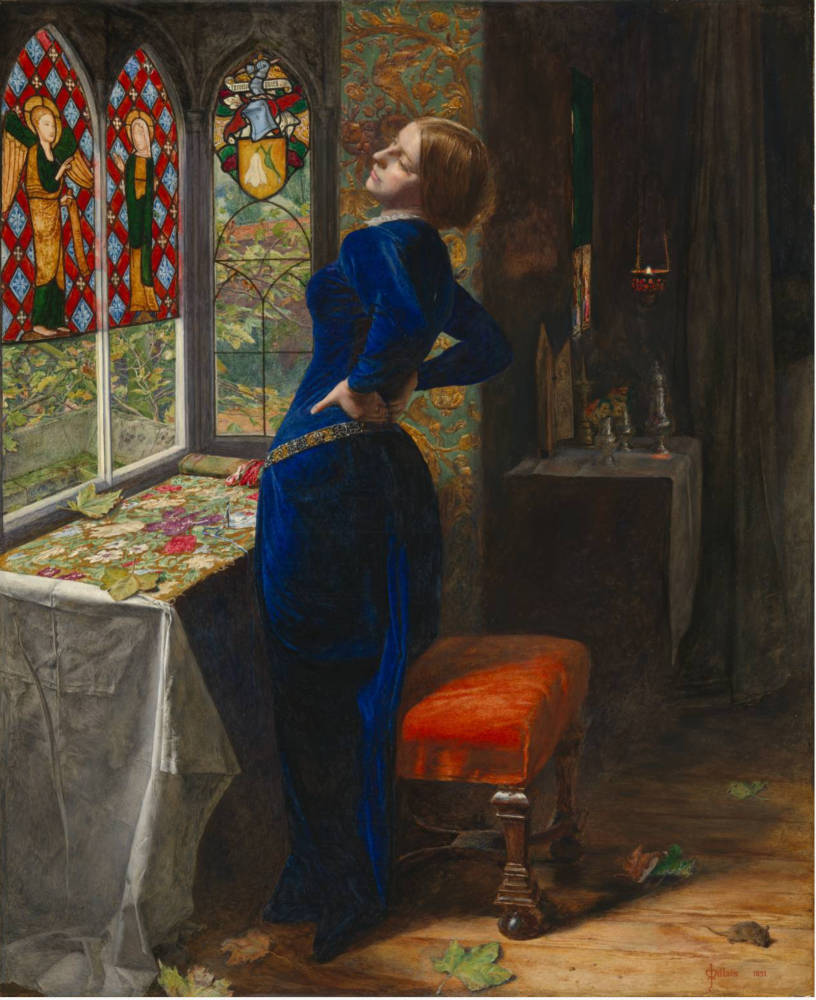 The painting Mariana by Sir John Everett Millais depicts a scene from Tennyson's poem "Mariana" of 1830. Tennyson's poem, inspired by Shakespeare's Measure for Measure tells the story of Mariana, a young woman isolated in a moated grange awaiting the return of her fiancé Angelo. He has, in fact, abandoned her, after her dowry was lost at sea. The painting depicts the woman richly dressed rising to stretch from the embroidery she is working on. Millais pays careful attention and extreme detail to her surroundings as the rooms in PRB paintings often became the symbolic embodiment of the woman or story. Nature is also a strong theme in the painting from the leaves and wooded landscape to the strong light and shadow cast from the window. The painting, although superficially depicting romantic themes has strong Tractarian undercurrents. The altar and altarpiece as well as the censer (container for burning incense) and the stained glass all interject religious narratives to the scene.
The painting Mariana by Sir John Everett Millais depicts a scene from Tennyson's poem "Mariana" of 1830. Tennyson's poem, inspired by Shakespeare's Measure for Measure tells the story of Mariana, a young woman isolated in a moated grange awaiting the return of her fiancé Angelo. He has, in fact, abandoned her, after her dowry was lost at sea. The painting depicts the woman richly dressed rising to stretch from the embroidery she is working on. Millais pays careful attention and extreme detail to her surroundings as the rooms in PRB paintings often became the symbolic embodiment of the woman or story. Nature is also a strong theme in the painting from the leaves and wooded landscape to the strong light and shadow cast from the window. The painting, although superficially depicting romantic themes has strong Tractarian undercurrents. The altar and altarpiece as well as the censer (container for burning incense) and the stained glass all interject religious narratives to the scene.
The stained glass windows in front of Mariana form a triptych, which was a form classically used in religious works or altarpieces. This triptych provides a clue to the overriding message of the painting. The scene of the Annunciation shows the Virgin Mary approached by the Angel Gabriel. According to Luke, the Angel approached Mary while she was still in the house of her mother despite being promised to Joseph in marriage. Mariana's situation is one of similar limbo. She is promised to Angelo but waits in a sort of limbo for the matter of her dowry to be resolved. In Mallais' depiction of the scene, though, the angel, Gabriel, does not speak to Mary but instead seems to lure Mariana from the window gesturing with his two figures. The third panel of the triptych shows a shield. A helmet with a protruding devil's horn, a phallic symbol, towers threateningly above the flower of the snowdrop, which symbolizes the purity of the Virgin. These elements thus present a story of temptation. The woman seems to be lured by Gabriel, her purity being crushed by a male force. Mariana finds herself weary, sexually frustrated and tense awaiting Angelo's return. The moral preaching of the PRB continues in this secular representation of the Annunciation.
The characterization of Nature in the scene echoes the religious narrative presented in Mariana. The fallen leaves suggest the passage of time and the end of summer. Quite literally, this could be the end of flowering and growth or the end of Mariana's purity (as it was symbolized as a flower). The autumn leaves outside her window seem to close in on the space, aided by the flat natured technique of Pre-Raphaelite painting. It is evident that the days of summer, fertility and purity are at an end. Winter, desolation and solitude begin to close in on Mariana.
Questions
1. The embroidery that Mariana is working on seems to be highlighted and given significance based on the casting of light from the window. What could it possibly tell us about Mariana and her story?
2. Does the blue colouring of Mariana's dress is the most vibrant and noticeable colour in the painting. What is it meant to tell us about her character?
3. The religious objects on Mariana's table seem to form an altar (the triptych on the table as well as the censer, etc.). Why are they left in the dark? Does Millais mean to pay them less attention or is their significance to their positioning?
4. Mariana's pose has been described as one of sexual frustration and tension. Does it also mimic or echo any easily identifiable religious or classical poses?
Related Materials
Questions
Bibliography
Millais, John Guile. The Life and Letters of John Everett Millais, President of the Royal Academy. 2 vols. New York: Frederick A. Stokes, 1899.
Last modified 27 September 2004